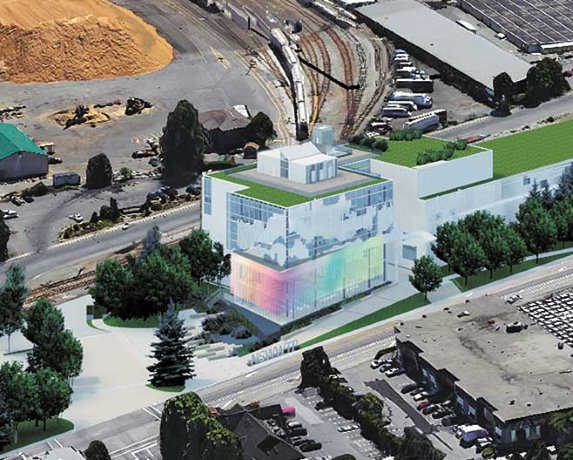On a site near Burrard Inlet in North Vancouver builders are commencing work on what will be the city’s $525-million wastewater treatment plant. But unlike most treatment plants that are spread over large properties, the new facility will be on a tight site — 3.5 hectares. By comparison, a plant with similar capacity on Lulu Island, in the Vancouver suburb of Richmond, sprawls over 10 hectares.
With space at a premium, the design looks up rather than out, says Paul Dufault, the project manager of the North Shore Wastewater Treatment Plant (NSWTP) project.
"It is a stacked vertical plant," he says.
The reinforced concrete structures, described by an architect as "basically a 100-storey building on its side," include tanks and two round digesters about 100 feet high, the tallest buildings on site.
The land poses a number of challenges for the building team led by ACCIONA, the design-build contractor which commenced construction in the spring. Along with the site constraints, vehicular traffic on the North Shore is heavy and can impede construction schedules.
"They are confined by roads on three sides and a railway on the fourth side," says Dufault.
Early in the construction schedule parking will be available within the site but as work progresses and buildings go up, finding alternative parking for construction crews off-site in an area that is now parking-challenged will be on the agenda.
The team behind the project will also be looking at alternative means of bringing in materials to reduce traffic disruptions.
Dufault adds the building team will look at having as much prefabrication done off-site as possible to eliminate materials and supply deliveries.
He says ACCIONA is assessing the possibility of having a concrete batch plant set up nearby to minimize transportation.
"There are no concrete plants on the North Shore."
The new plant will replace the 60-year-old Lion’s Gate treatment plant when it begins operations in about three years.
It will serve up to 250,000 residents. North Vancouver has a population of 180,000 which is expected to climb to 250,000 by the mid-century.
The property was formerly owned by B.C. Rail. While structures were removed four years ago, concrete foundations remained and are currently being demolished and removed.
Dufault says test sections for stone columns for ground improvement are underway.
He says ACCIONA was given the option of stone columns or traditional piles — the contractor chose the former in part because it was "a bit faster" while providing "equal seismic performance."
The use of stone columns for soil improvement is common on B.C.’s west coast.
"They are a way of densifying the ground as opposed to building a support structure," he says.
At the treatment plant, the stones are driven 27 metres deep in a slurry mix to create the columns.
He says the stones were shipped by barge to the site, eliminating the need for 1,500 truckloads that would have created traffic snarls on the busy surrounding streets.
Once the columns are in place the site will be pre-loaded, which is slated for completion next February. Excavation will follow.
Areas excavated deeper than five feet will be reinforced from the sea with secant piling — reinforced concrete walls, says Dufault.
Overall, the new treatment and associated works has a $700 million budget, separated into three parts, including $525 million for the plant. Also on tap is the construction of a pump station and two pipelines about two kilometres long from the Lion’s Gate treatment plant project to the west.
Once the new plant is operational, the Lion’s Gate facility will be decommissioned and that land will be turned back to the Squamish Nation Reserve.
The design-build-finance project is receiving $212.3 million from the federal government, $193 million from the province and the remainder from Metro Vancouver.
To meet new wastewater regulatory deadlines, the plant must be completed by Dec. 31, 2020, says Dufault.

The $525-million North Shore Wastewater Treatment Plant is being built by a team led by ACCIONA. Construction started this spring on the tight 3.5 hectare site. The reinforced concrete structures for the project have been described as a 100-storey building on its side.
Photo: Acciona Design Build Joint Venture"










Recent Comments
comments for this post are closed